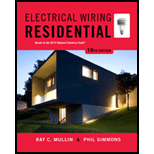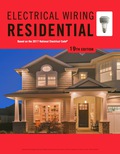
Electrical Wiring Residential
18th Edition
ISBN: 9781285170954
Author: Ray C. Mullin, Phil Simmons
Publisher: Cengage Learning
expand_more
expand_more
format_list_bulleted
Concept explainers
Question
Chapter 27, Problem 24R
To determine
Find the type of bushing required on service entrances.
Expert Solution & Answer
Trending nowThis is a popular solution!

Students have asked these similar questions
5. A schematic diagram of a motor connected to
a load by gears is shown. Both the motor and
the load are modeled as rotating masses with
viscous damping. Find the transfer functions
Øm/Tm and ØL/Tm.
bm
Jm
Tm 0m
N₂
N₁
OL
но
JL
b₁
3. Find the transfer function X2/F of the
mechanical system in Figure.
Κι
www
b₁
M₁
K2
www
M2
b2
X2
F
b3
S1(t)
Es/Ts
0
S3(t)
0
Es/Ts
Ts
t
S2(t)
Es/Ts
0
Es/Ts
Ts
|7|2
S4(t)
Es/Ts
t
Ts
t
0
Ts
Ts
Ts
Es/TS
2
1/
Q1(t)
42(t)
Ts
1JT
0
t
0
Ts
Ts
2
32
FIGURE 7.3 Set of signals and orthonormal functions for Example 7.1.
53(t)=√√Esq₁(t)
S4(t)=-√E542(t)
t
Ts
Chapter 27 Solutions
Electrical Wiring Residential
Ch. 27 - Define the Service Point. ______________Ch. 27 - Define service-drop conductors.Ch. 27 - Prob. 3RCh. 27 - a. The service head must be located (above)...Ch. 27 - Prob. 5RCh. 27 - When a conduit is extended through a roof, must it...Ch. 27 - a. What size and type of conductors are installed...Ch. 27 - How and where is the grounding electrode conductor...Ch. 27 - What are the minimum distances or clearances for...Ch. 27 - What are the minimum size ungrounded conductors...
Ch. 27 - What is the minimum size copper grounding...Ch. 27 - What is the recommended height of a meter socket...Ch. 27 - Prob. 13RCh. 27 - Prob. 14RCh. 27 - Prob. 15RCh. 27 - Prob. 16RCh. 27 - Prob. 17RCh. 27 - Prob. 18RCh. 27 - Prob. 19RCh. 27 - Prob. 20RCh. 27 - Prob. 21RCh. 27 - Prob. 22RCh. 27 - Prob. 23RCh. 27 - Prob. 24RCh. 27 - Prob. 25RCh. 27 - Prob. 26RCh. 27 - Prob. 27RCh. 27 - Prob. 28RCh. 27 - Prob. 29RCh. 27 - Prob. 30RCh. 27 - Prob. 31RCh. 27 - Prob. 32RCh. 27 - Prob. 33RCh. 27 - Prob. 34RCh. 27 - Prob. 35RCh. 27 - Prob. 36RCh. 27 - Prob. 37RCh. 27 - Prob. 38RCh. 27 - Prob. 39RCh. 27 - Prob. 40RCh. 27 - Prob. 42RCh. 27 - Prob. 43RCh. 27 - Prob. 44RCh. 27 - Prob. 45RCh. 27 - Prob. 46RCh. 27 - Prob. 47RCh. 27 - Prob. 48R
Knowledge Booster
Learn more about
Need a deep-dive on the concept behind this application? Look no further. Learn more about this topic, electrical-engineering and related others by exploring similar questions and additional content below.Similar questions
- 1. For each of the following differential equations, determine the transfer function Y/U. Determine if the transfer function is proper or strictly proper. is not strictly proper, determine the strictly proper part. If it (a) y(3) = -3y(2) - 3y(1) — 2y + u(2) — - (b) y(3)=-3.5y(2) — 3.5y(1) — y +u(3) — 3.5u(2) + 3.5u(¹) + 3uarrow_forward.4. Find the transfer function Ø2/T of the mechanical system in Figure. TG K 02 b₁ b₂ b3arrow_forwardMatlab problem: 1) A BFSK signal is transmitted through a channel with AWGN. Generate similar BFSK received signal plots as shown below. (20 pts) BFSK for eb=1 and npower=0.01 with 500 samples BFSK for eb=1 and npower=0.1 with 500 samples 2.5 2.5 2 1.5 1 0.5 0 -0.5 -1 2 1.5 1 0.5 0.5 -1 -1.5 1.5 -1.5 -1 -0.5 0 0.5 1.5 2 2.5 -1.5 -0.5 0 0.5 1 1.5 2 2.5arrow_forward
- example 7.1 question EXAMPLE 7.1Consider the signals s1(t), s2(t), s3(t), and s4(t) shown in Figure 7.3. Using the Gram-Schmidt orthogonalization procedure, determine a set of orthonormal basis functions.Using the waveforms derived and shown in Example 7.1:a) Sketch the simplified block diagram of the transmitter and receiver as shown in figure 7.2b) Estimate the receive voltages for each transmit signal and for each branch in the receiver.arrow_forwardEXAMPLE 7.2 Consider the two equally-likely signals s₁ (t) and s2(t) that are transmitted, over an AWGN channel with the noise power spectral density of No/2, to represent bits 1 and 0, where we have: S1(t)=-S2(t)=√√2 exp(-2t)u(t) The receiver makes its decision solely based on observation of the received signal over a restricted interval of interest. Determine the average bit error rate in terms of Q-function, assuming the interval is [0,3]. Contrast numerically with the performance of an optimum receiver that observes. all the received signal, i.e., the interval of interest is (-∞, ∞).arrow_forward1) Compute the voltages at each receiver branch (Vo ad V₁ see block diagram next page) for each of the possible transmitted signals: Transmitted signals are generated as shown below: Binary wave in unipolar form (a) With basis functions: Inverter 41(t) Product modulator Product modulator 42(t) BFSK + signal + Si(t) P1(t)= √Eb = cos (2лfit+0₁) $2(t) 42(t)= √Eb 层 cos (2лf2t+ t+02) Generating signals: 2E Si(t) cos (2лfit+0₁), bit=0 Ть SBFSK (t) 2E |$2(t)= cos (2лf2t+02), bit=1arrow_forward
- Find the disruptive voltage and visual corona voltage for 3-phase line consisting of 2.5 cm diameter conductor spaced equilateral triangular formation of 4 m. The following data can be assumed, temperature 25°c, pressure 73 cm of mercury, surface factor 0.84, irregularity factor 0.72.arrow_forwardA 3-phase, 4-wire distributor supplies a balanced voltage of 400/230 V to a load consisting of 8 A at p.f. 0-7 lagging for R-phase, 10 A at p.f. 0-8 leading for Y phase and 12 A at unity p.f. for B phase. The resistance of each line conductor is 0.4 2. The reactance of neutral is 0.2 2. Calculate the neutral current, the suppl voltage for R phase and draw the phasor diagram. The phase sequence is RYB. VR Phasor diagramarrow_forwardThe three line leads of a 400/230 V, 3-phase, 4-wire supply are designated as R, Y and B respectively. The fourth wire or neutral wire is designated as N. The phase sequence is RYB. Compute the currents in the four wire when the following loads are connected to this supply: From R to N: 25 kW, unity power facto. From Y to N: 20 kVA, 0-7 lag. From B to N: 30 kVA, 0-6 lead.arrow_forward
- 2) Is the following set of basis functions orthogonal? 41(t) = √== cos (2Ãfet), 0 ≤1≤T₁ P2(t)= - \ con(A). 2 VTS sin (2лfet), 0arrow_forwardPick up the correct answer It must be accurate 2. the minimum phase-neutral voltage at which corona occurs is A. Visual critical voltage B. Receiving voltage C. String voltage D. Critical disruptive voltage. 3. If the length of a transmission line increases, its inductance is A. Increases B. Decreases C. Constant 4. Photo cells are connected in parallel in order to A. Increase voltage rating D. None of them B. Increase current rating C. Increase life cells. D. All of the them 6. Best diversity factor will be at: B. More D. diversity factor >1 than sending voltage A. diversity factor <1 B. diversity factor = 1 C. diversity factor = zero 7. When the voltage regulation is positive, then receiving voltage is A. Less C. Equal D. None of the them 8. Fill factor of solar cell using the data: Pmax= 10 w, Voc= 5 V, Isc= 1 A A.5 9. The string efficiency can be reduced by using: B. 2 C. 1 D. 10 A. Guard ring B. Equal insulator voltage C. less cross arm D. None of them 10. If the spacing between…arrow_forwardDon't use ai to answer I will report you answerarrow_forwardarrow_back_iosSEE MORE QUESTIONSarrow_forward_ios
Recommended textbooks for you
 EBK ELECTRICAL WIRING RESIDENTIALElectrical EngineeringISBN:9781337516549Author:SimmonsPublisher:CENGAGE LEARNING - CONSIGNMENT
EBK ELECTRICAL WIRING RESIDENTIALElectrical EngineeringISBN:9781337516549Author:SimmonsPublisher:CENGAGE LEARNING - CONSIGNMENT Delmar's Standard Textbook Of ElectricityElectrical EngineeringISBN:9781337900348Author:Stephen L. HermanPublisher:Cengage Learning
Delmar's Standard Textbook Of ElectricityElectrical EngineeringISBN:9781337900348Author:Stephen L. HermanPublisher:Cengage Learning

EBK ELECTRICAL WIRING RESIDENTIAL
Electrical Engineering
ISBN:9781337516549
Author:Simmons
Publisher:CENGAGE LEARNING - CONSIGNMENT

Delmar's Standard Textbook Of Electricity
Electrical Engineering
ISBN:9781337900348
Author:Stephen L. Herman
Publisher:Cengage Learning
What is an electric furnace and how does it work?; Author: Fire & Ice Heating and Air Conditioning Inc;https://www.youtube.com/watch?v=wjAWecPGi0M;License: Standard Youtube License